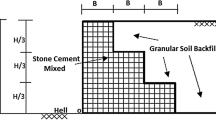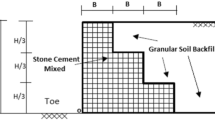Abstract
This paper presents intelligent models for solving problems related to retaining walls in geotechnics. To do this, safety factors of 2800 retaining walls were modeled and recorded considering different effective parameters of retaining walls (RWs), i.e., height of the wall, wall thickness, friction angle, density of the soil, and density of the rock. Two intelligent methodologies including a pre-developed artificial neural network (ANN) and a combination of artificial bee colony (ABC) and ANN were selectively developed to approximate safety factors of RWs. In the new network, ABC was used to optimize weight and biases of ANN to receive higher level of accuracy and performance prediction. Many ANN and ABC–ANN models were built considering the most influential parameters of them and their performances were evaluated using coefficient of determination (R2) and root mean square error (RMSE) performance indices. After developing the mentioned models, it was found that the new hybrid model is able to increase network performance capacity significantly. For instance, R2 values of 0.982 and 0.985 for training and testing of ABC–ANN model, respectively, compared to these values of 0.920 and 0.924 for ANN model showed that the new hybrid model can be introduced as a capable enough technique in the field of this study for estimating safety factors of RWs.









Similar content being viewed by others
Explore related subjects
Discover the latest articles and news from researchers in related subjects, suggested using machine learning.References
Coulomb CA (1776) Essai sur une Application des Règles de Maximis et Minimis à Quelques Problèmes de Statique Relatifs à L’Architecture. Mèmoires de la Mathèmatique et de Phisique, présentés à l’Académie Royale des Sciences, par divers savans, et lûs dans sés Assemblées. Annee 1793:343–382
Rankine WJM (1857) On the mathematical theory of the stability of earthwork and masonry. J Frankl Inst 63:84–85
Terzaghi K (1943) Theoretical soil mechanics. Wiley, New York
Leshchinsky D, Vulova C (2001) Numerical investigation of the effects of geosynthetic spacing on failure mechanisms in MSE block walls. Geosynth Int 8:343–365
Yu G-Y, Bai Y-S, Sheng P, Guo R-P (2009) Mechanical performance of a double-face reinforced retaining wall in an area disturbed by mining. Min Sci Technol 19:36–39
Chan YC (1996) Study of old masonry retaining walls in Hong Kong. GEO Report No. 31, Geotechnical Engineering Office, Civil Engineering Department, Hong Kong
Rankine WJM (1857) On the stability of loose earth. Philos Trans R Soc Lond 9–27
Tsagareli ZV (1965) Experimental investigation of the pressure of a loose medium on retaining walls with a vertical back face and horizontal backfill surface. Soil Mech Found Eng 2:197–200
Chang M-F (1997) Lateral earth pressures behind rotating walls. Can Geotech J 34:498–509
O’Neal TS, Hagerty DJ (2011) Earth pressures in confined cohesionless backfill against tall rigid walls—a case history. Can Geotech J 48:1188–1197
Iskander M, Chen Z, Omidvar M et al (2013) Active static and seismic earth pressure for c–f soils. Soils Found 53:639–652
Armaghani DJ, Hasanipanah M, Mohamad ET (2016) A combination of the ICA-ANN model to predict air-overpressure resulting from blasting. Eng Comput 32:155–171. https://doi.org/10.1007/s00366-015-0408-z
Armaghani DJ, Mohamad ET, Narayanasamy MS et al (2017) Development of hybrid intelligent models for predicting TBM penetration rate in hard rock condition. Tunn Undergr Sp Technol 63:29–43. https://doi.org/10.1016/j.tust.2016.12.009
Koopialipoor M, Jahed Armaghani D, Haghighi M, Ghaleini EN (2017) A neuro-genetic predictive model to approximate overbreak induced by drilling and blasting operation in tunnels. Bull Eng Geol Environ. https://doi.org/10.1007/s10064-017-1116-2
Saghatforoush A, Monjezi M, Faradonbeh RS, Armaghani DJ (2016) Combination of neural network and ant colony optimization algorithms for prediction and optimization of flyrock and back-break induced by blasting. Eng Comput 32:255–266
Saghatforoush A, Monjezi M, Shirani Faradonbeh R, Jahed Armaghani D (2016) Combination of neural network and ant colony optimization algorithms for prediction and optimization of flyrock and back-break induced by blasting. Eng Comput. https://doi.org/10.1007/s00366-015-0415-0
Tonnizam Mohamad E, Hajihassani M, Jahed Armaghani D, Marto A (2012) Simulation of blasting-induced air overpressure by means of artificial neural networks. Int Rev Model Simul 5:2501–2506
Mohamad ET, Faradonbeh RS, Armaghani DJ, Monjezi M, Majid MZ (2016) An optimized ANN model based on genetic algorithm for predicting ripping production. Neural Comput Appl 28(1):393–406
Hasanipanah M, Armaghani DJ, Amnieh HB, Koopialipoor M, Arab H (2018) A risk-based technique to analyze flyrock results through rock engineering system. Geotech Geol Eng. https://doi.org/10.1007/s10706-018-0459-1
Koopialipoor M, Fallah A, Armaghani DJ et al (2018) Three hybrid intelligent models in estimating flyrock distance resulting from blasting. Eng Comput. https://doi.org/10.1007/s00366-018-0596-4
Koopialipoor M, Armaghani DJ, Hedayat A et al (2018) Applying various hybrid intelligent systems to evaluate and predict slope stability under static and dynamic conditions. Soft Comput. https://doi.org/10.1007/s00500-018-3253-3
Safa M, Shariati M, Ibrahim Z et al (2016) Potential of adaptive neuro fuzzy inference system for evaluating the factors affecting steel-concrete composite beam’s shear strength. Steel Compos Struct 21:679–688
Safa A, Rashidinejad HR, Khalili M et al (2016) Higher circulating levels of chemokines CXCL10, CCL20 and CCL22 in patients with ischemic heart disease. Cytokine 83:147–157
Mansouri I, Shariati M, Safa M et al (2017) Analysis of influential factors for predicting the shear strength of a V-shaped angle shear connector in composite beams using an adaptive neuro-fuzzy technique. J Intell Manuf. https://doi.org/10.1007/s10845-017-1306-6
Duncan JM (2000) Factors of safety and reliability in geotechnical engineering. J Geotech Geoenviron Eng 126:307–316
Toghroli A, Mohammadhassani M, Suhatril M et al (2014) Prediction of shear capacity of channel shear connectors using the ANFIS model. Steel Compos Struct 17:623–639
Toghroli A, Suhatril M, Ibrahim Z et al (2016) Potential of soft computing approach for evaluating the factors affecting the capacity of steel–concrete composite beam. J Intell Manuf. https://doi.org/10.1007/s10845-016-1217-y
Fenton GA, Griffiths DV, Williams MB (2007) Reliability of traditional retaining wall design. Risk Var Geotech Eng. Thomas Telford Publishing, pp 165–172
Gudehus G, Touplikiotis A (2018) On the stability of geotechnical systems and its fractal progressive loss. Acta Geotech 13:317–328
Li M, Jiang R, Ge SS, Lee TH (2017) Role playing learning for socially concomitant mobile robot navigation. arXiv Prepr. arXiv:1705.10092
Ma J, Jiang X, Gong M (2018) Two-phase clustering algorithm with density exploring distance measure. CAAI Trans Intell Technol 3:59–64
Guan X, Liao S, Bai J et al (2017) Urban land-use classification by combining high-resolution optical and long-wave infrared images. Geospat Inf Sci 20:299–308
Zhao B, Gao L, Liao W, Zhang B (2017) A new kernel method for hyperspectral image feature extraction. Geospat Inf Sci 20:309–318
Tracewski L, Bastin L, Fonte CC (2017) Repurposing a deep learning network to filter and classify volunteered photographs for land cover and land use characterization. Geospat Inf Sci 20:252–268
Khandelwal M, Armaghani DJ (2016) Prediction of drillability of rocks with strength properties using a hybrid GA-ANN technique. Geotech Geol Eng 34:605–620. https://doi.org/10.1007/s10706-015-9970-9
Hasanipanah M, Noorian-Bidgoli M, Jahed Armaghani D, Khamesi H (2016) Feasibility of PSO-ANN model for predicting surface settlement caused by tunneling. Eng Comput. https://doi.org/10.1007/s00366-016-0447-0
Hasanipanah M, Jahed Armaghani D, Bakhshandeh Amnieh H et al (2016) Application of PSO to develop a powerful equation for prediction of flyrock due to blasting. Neural Comput Appl. https://doi.org/10.1007/s00521-016-2434-1
Gandomi AH, Kashani AR, Roke DA, Mousavi M (2017) Optimization of retaining wall design using evolutionary algorithms. Struct Multidiscip Optim 55:809–825
Peck RB, Hanson WE, Thornburn TH (1974) Foundation engineering. Wiley, New York
Zurada JM (1992) Introduction to artificial neural systems. West, St. Paul
McCulloch WS, Pitts W (1943) A logical calculus of the ideas immanent in nervous activity. Bull Math Biophys 5:115–133
Ch S, Mathur S (2012) Particle swarm optimization trained neural network for aquifer parameter estimation. KSCE J Civ Eng 16:298–307
Simpson PK (1990) Artificial neural systems. Pergamon Press, Oxford
Mohandes MA (2012) Modeling global solar radiation using particle swarm optimization (PSO). Sol Energy 86:3137–3145
Haykin S (1999) Neural networks. Prentice Hall, Upper Saddle River
Priddy KL, Keller PE (2005) Artificial neural networks: an introduction. SPIE Press, Bellingham
Ahmadi MA, Shadizadeh SR (2012) New approach for prediction of asphaltene precipitation due to natural depletion by using evolutionary algorithm concept. Fuel 102:716–723
Armaghani DJ, Mohamad ET, Hajihassani M et al (2016) Application of several non-linear prediction tools for estimating uniaxial compressive strength of granitic rocks and comparison of their performances. Eng Comput 32:189–206
Karaboga D (2005) An idea based on honey bee swarm for numerical optimization. Technical report-tr06. Computer Engineering Department, Engineering Faculty, Erciyes University, Kayseri
Nozohour-leilabady B, Fazelabdolabadi B (2016) On the application of artificial bee colony (ABC) algorithm for optimization of well placements in fractured reservoirs; efficiency comparison with the particle swarm optimization (PSO) methodology. Petroleum 2:79–89
Ahmad A, Razali SFM, Mohamed ZS, El-shafie A (2016) The application of artificial bee colony and gravitational search algorithm in reservoir optimization. Water Resour Manag 30:2497–2516
Zhang C, Ouyang D, Ning J (2010) An artificial bee colony approach for clustering. Expert Syst Appl 37:4761–4767
Rodriguez FJ, García-Martínez C, Blum C, Lozano M (2012) An artificial bee colony algorithm for the unrelated parallel machines scheduling problem. In: Int. Conf. Parallel Probl. Solving from Nat. Springer, Berlin, pp 143–152
de Oliveira IMS, Schirru R, de Medeirose JACC (2009) On the performance of an artificial bee colony optimization algorithm applied to the accident diagnosis in a pwr nuclear power plant. In: International nuclear atlantic conference-INAC, vol 1, Rio de Janeiro, Brazil
Irani R, Nasimi R (2011) Application of artificial bee colony-based neural network in bottom hole pressure prediction in underbalanced drilling. J Pet Sci Eng 78:6–12
Ebrahimi E, Monjezi M, Khalesi MR, Armaghani DJ (2016) Prediction and optimization of back-break and rock fragmentation using an artificial neural network and a bee colony algorithm. Bull Eng Geol Environ 75:27–36
Karaboga D, Basturk B (2007) A powerful and efficient algorithm for numerical function optimization: artificial bee colony (ABC) algorithm. J Glob Optim 39:459–471
Karaboga D, Akay B (2007) Artificial bee colony (ABC) algorithm on training artificial neural networks. In: IEEE 15th conference on signal processing and communications applications 2007. SIU 2007, 11 June 2007. IEEE, pp 1–4
Hornik K, Stinchcombe M, White H (1989) Multilayer feedforward networks are universal approximators. Neural Netw 2:359–366
Hecht-Nielsen R (1987) Kolmogorov’s mapping neural network existence theorem. In: Proceedings of the international conference on Neural Networks, pp 11–14, IEEE Press
Ripley BD (1993) Statistical aspects of neural networks. Netw Chaos Stat Prob Asp 50:40–123
Paola JD (1994) Neural network classification of multispectral imagery. Master Tezi, Univ. Arizona, Tucson
Wang C (1994) A theory of generalization in learning machines with neural application. PhD thesis, The University of Pennsylvania, USA
Masters T (1993) Practical neural network recipes in C++. Morgan Kaufmann, Burlington
Kanellopoulos I, Wilkinson GG (1997) Strategies and best practice for neural network image classification. Int J Remote Sens 18:711–725
Kaastra I, Boyd M (1996) Designing a neural network for forecasting financial and economic time series. Neurocomputing 10:215–236
Zorlu K, Gokceoglu C, Ocakoglu F et al (2008) Prediction of uniaxial compressive strength of sandstones using petrography-based models. Eng Geol 96:141–158
Author information
Authors and Affiliations
Corresponding author
Additional information
Publisher’s Note
Springer Nature remains neutral with regard to jurisdictional claims in published maps and institutional affiliations.
Rights and permissions
About this article
Cite this article
Ghaleini, E.N., Koopialipoor, M., Momenzadeh, M. et al. A combination of artificial bee colony and neural network for approximating the safety factor of retaining walls. Engineering with Computers 35, 647–658 (2019). https://doi.org/10.1007/s00366-018-0625-3
Received:
Accepted:
Published:
Issue Date:
DOI: https://doi.org/10.1007/s00366-018-0625-3




